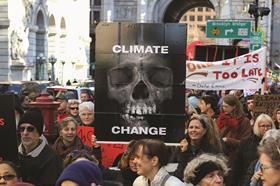At this week’s UN Climate Change Summit, the UK could no longer boast of having the greenest policies in the room. So after several months of Conservative policy changes, how is the country measuring up to its own targets?

The Paris terror attacks have cast an eerie mood on the UN Climate Change Summit, being held in the same venue - the Stade de France - as one of those hit by armed Islamic militants just three weeks ago. Some of the fringe events around the conference and parts of the first ever Buildings Day - which took place last week - have had to be curtailed in the service of the heightened security clearly required for such a high level meeting of heads of state, so soon after the attacks.
Nevertheless, hopes remain robust that the summit, which comes to a climax today, will still be able to choreograph the kind of global climate change treaty that has remained so elusive since the historic Kyoto Protocol was adopted nearly 20 years ago - albeit it is likely to be without the binding legal safeguards.
UK delegates will have additional reasons to view the summit with mixed emotions. This is because in recent years UK climate change negotiators have been used to being able to stand tall in international climate talks, confident that UK policies such as the 2008 Climate Change Act - which passed into law the requirement to meet carbon reduction targets - and the 2016 Zero Carbon target for new build housing, made the country a genuine leader on the world stage. But a series of policy U-turns since the election of a majority Conservative government (see U-turns box) in May - according to no less a figure than former US vice president Al Gore, who delivered an unprecedented tongue-lashing to the UK in September - have seriously dented this reputation.
While the new climate change secretary, Amber Rudd, who is a firm believer in climate change science, says the changes won’t jeopardise the UK’s ability to meet its targets, there is nevertheless huge concern over the direction of travel. As John Cridland, director general of the CBI, said at the same conference at which Gore was speaking, the moves “send a worrying signal about the UK as a place for low-carbon investment.” So, as the national leaders work to pull together a wider agreement at the climax of talks today, what is the evidence that recent government moves will undermine this bid, and what do the policies really mean for our ability to meet our commitments?
Progress

Trying to track the UK’s progress on its own carbon emission reduction ambitions is not an activity for the faint-hearted, such is the complexity involved. Overall, the number is clear and relatively simple - the UK needs to reduce carbon emissions by 80% by 2050 against the level emitted in 1990. To get us there, five “carbon budgets” have been produced, setting out annual emissions levels for the period up to 2031 and how to achieve it - with the most recent detailed just last month. The good news, according to the body set up to set the budgets and monitor progress against them, is that so far we’re on course to meet the 29% reduction needed by 2017, and the 35% reduction needed for the period from 2018 to 2022. After that, however, the body - the Committee for Climate Change (CCC) - says it all starts to get a lot more challenging, with a 50% reduction required for the 2023-27 period. Nevertheless in 2014 alone, says the CCC, greenhouse gas emissions reduced by 8% on the prior year.
These figures, covering overall carbon emissions, can, however, give a misleading impression of progress, as they are impacted by factors such as the weather (warmer winters mean fewer emissions, such as in 2014), and the amount of economic activity (a growing economy means more emissions). Moreover, the starting date against which UK carbon reductions are calculated flatters the UK - with the decision to turn away from coal-fired power stations in the 1990s making up a large proportion of our progress so far. Some say that has allowed the UK to avoid addressing some of the more difficult questions - such as those around that energy efficiency of existing buildings - that need to be tackled to meet later targets. “The reality is we haven’t made anywhere near the progress of other countries,” says former ACE president Andrew Warren. “We’re living through the sort of debates now that the Germans and Dutch went through 15 years ago.”
This issue led the CCC to conclude, even prior to recent policy changes, that despite the appearance of progress, “concerns remain about underlying progress, and about whether progress can be sustained through the 2020s. Significant action is required in the new Parliament in order to […] stay on track to the 2050 target.” Moreover, it adds, in a diplomatic rebuke to the government, that “the key risk to future progress is the current uncertainty over the long-term policy framework.”
The real problems, as the publication of the fifth carbon budget last month made clear, come after 2020, when the need to ramp up neglected areas such as renewable heat generation and building efficiency become much more acute.
While this is the overall framework for UK emissions, more tangible for the construction and infrastructure sector are the sub-targets for the sector published in the last parliament under the Low Carbon Transition Plan. According to the CCC, emissions from buildings make up 34% of UK emissions, with households accounting for two-thirds of that. The transition plan called for a 29% reduction in carbon emissions from homes by 2020 and 13% reduction in non-domestic buildings. Here progress has slowed considerably in recent years (see retrofit box) with the introduction, failure and cancellation of the Green Deal. This is despite the insistence of the CCC - whose remit is to plot the cheapest way to achieve the desired emission reductions - that activity has to ramp up.

Shortfall
Also more concrete for the sector than the 2008 Act’s overall emission targets are EU targets on renewable energy generation, under which the UK has signed up to see 15% of all power - electricity, heating and transport, produced from renewable sources by 2020. Under this overall aim are sub-targets that 30% of electricity should come from renewables, and 10% of transport fuel. Again, the UK has so far claimed to be “making progress toward these targets”.
However, a letter from Amber Rudd to other departments, leaked to the Ecologist last month, revealed that internal government forecasts paint a different picture, showing that DECC is considering a series of measures to address a looming shortfall. Hauled in front of MPs to discuss the disparity, Rudd admitted: “I recognise that we don’t have the right policies, particularly in transport and heat […] in order to make those 2020 targets.”
Rudd, however, claims that while there may be a shortfall against the target, the problem is in the area of transport fuel and heat from renewable sources, not electricity generation. And therefore that it wouldn’t be right simply to boost renewable electricity generation to solve the shortfall. In other words she contends that the U-turns on renewables - which the Renewables Energy Association says have caused a drop in investor confidence in the sector - have not caused the problem and shouldn’t be reversed. Of course all this is hotly disputed by those in the renewable generation industry who have seen their subsidies slashed.
Also, while missing these EU targets, as the leaked letter makes clear, would leave the UK open to being fined by the European Commission, it would not necessarily mean it had missed its broader legal commitments under the 2008 Climate Change Act.
Overall, then, the picture is one where progress on total emissions, made in large part through luck rather than dedicated policy design, is being undercut by reversals in individual policy areas likely to be fundamental to hitting more stringent targets in the 2020s and 2030s. The more immediate effect, though, is likely to have been felt in Paris this week, as UK negotiators tried to do their bit to persuade other countries to set similarly high aspirations. John Alker, policy director at the UK Green Building Council, says: “It definitely makes selling the case for carbon reduction to other countries much harder when you’ve got a policy environment in this country that appears to be heading in the wrong direction.”
Speaking in Paris last week prime minister David Cameron made the moral case for tackling climate change, asking “what we would have to say to our grandchildren if we failed? […] Instead of making excuses tomorrow to our children and grandchildren, we should be taking action against climate change today.” Those campaigning for greater government action in the UK would argue that this rhetoric is not matched by policy. As Gore said of the UK in September: “Words. Words. What about actions? The actions that have been taken here in the last few months are puzzling to me.”
Climate change: The four built environment challenges
Low-carbon power generation infrastructure
Despite recent policy U-turns on renewable electricity generation, power generation remains the area where the government’s record of delivery is arguably strongest. According to the Climate Change Committee, renewable energy already contributes 20% of the UK’s electricity generation, up from 7% in 2007, with “low carbon” sources (including nuclear) now contributing 35% overall. This puts the UK currently on track to meet Climate Change Act targets, with the CCC saying schemes already contracted or under construction will be enough to hit the EU’s 30% target for electricity generation.
However, those in the industry say the government reversals, which including removing all subsidy for solar generation and onshore wind, will see 80% of the 35,000 jobs in the solar industry lost. John Forster, chairman of the Scottish Solar Trade Association, says the roll out of additional schemes to those already planned will be “drastically reduced.” The Comprehensive Spending Review saw the latest U-turn in this area, with the £1bn Carbon Capture and Storage competition cancelled.
Unsurprisingly, the CCC says it is concerned with the long-term picture, with policy changes meaning there is currently no certainty regarding subsidies for the various schemes such as solar farm subsidies, which come under the government’s Levy Control Framework. In its progress report in June, the CCC said: “The pipeline beyond 2020 is […] at risk given the high degree of uncertainty about the contracts that will be available to investors beyond 2020. These risks are increased by delays in previous years to carbon capture and storage and further delays this year for the new nuclear programme.”
Retrofit
In 2010, under the energy company-funded policies CERT and CESP, the UK was undertaking about 500,000 installations of cavity wall insulation and 1 million of loft insulation every year. Under the Green Deal and ECO, which replaced those policies, the installation of these measures collapsed, while there was a far smaller commensurate increase in solid wall insulation installations than was required to make up for it. Despite this reduction in progress, the coalition government cut ECO still further in 2013 in order to be able to demonstrate a reduction in energy bills, and then, in June, the new administration cut the Green Deal completely, putting nothing in its place. ECO comes to an end in 2017, and there is as yet no clarity on whether it will be renewed, and at what scale. Richard Twinn, senior policy adviser at the UK Green Building Council, says: “We’re currently in limbo in terms of a policy on retrofit, with energy efficiency the Cinderella of government energy policy. The economic case for action is overwhelming, but all indications are that any new policies will be less ambitious than what has gone before.”
The CCC says that as a minimum 1.35 million installations of cavity wall and solid wall insulation are needed by 2020 to hit its targets. However, the government’s manifesto commitment was for just 1 million low-carbon retrofits over the course of the 2015-2020 parliament - implying a further reduction on current levels. The CCC reports that progress on reducing emissions from buildings, once you adjust for climate and low-carbon power sources, has all but stalled, with commercial buildings performing particularly badly. It says that the government’s ambition to make 12% of the heat used in buildings generated from low-carbon sources by 2020 “no longer looks achievable,” with just 1.6% of heat generated this way in 2014. Even before Osborne cut £700m from the Renewable Heat Incentive (RHI) policy in the Comprehensive Spending Review, the CCC said there was “a mismatch between the ambition for the RHI and its role in driving low-carbon heat” and called for the government to develop an action plan.
New build standards
Alongside the challenge of increasing the energy efficiency of existing buildings, the UK government was from 2007 until this summer committed to a groundbreaking policy to make all new homes “zero carbon” by 2016 and likewise all new commercial buildings from 2019. The policy, cancelled in July, was a key part of the CCC plan for reductions in emissions from buildings, with DECC estimating that the zero carbon policy would have taken 2 million tonnes of carbon from emissions during the fourth carbon budget period (between 2018 and 2022). Under the EU performance of buildings directive, the UK is committed to reviewing its approach to low-carbon new build in 2017, but other than that, there is little expectation that there will be any further tightening of new build standards until the end of 2020, when the EU’s directive calls for all buildings to be “nearly zero energy”.
Louise Sunderland, senior policy adviser at the UKGBC, accepts that while the immediate carbon impact of the policy change will not be enormous, its emissions impact would be compounded each year as new homes are built at lower than anticipated standards. She says: “What would be really unhelpful is for the UK to be building large numbers of homes now that we have to retrofit in order to meet our carbon targets. That’s what we’re concerned about.”
Adaptation
The area where UK progress has been most concerning, according to the CCC, is in adapting to climate change in order that increasing temperatures and sea levels don’t cause undue harm or damage. The CCC is concerned that the government’s National Adaptation Programme has no specific funding and does not prioritise different measures. Two of the major adaptation issues climate change will cause for the built environment, as has been seen again this week in Cumbria, are general flood protection, minimising the pace of surface water drainage. The other major issue is overheating, with the number of heat-related deaths each year estimated to triple by the 2050s. All three are classified in the highest risk category by the CCC. It finds there is no plan for addressing residual flood risk for existing properties, and meanwhile, policy in the area of sustainable drainage systems has actually been weakened in recent years, with “local authorities […] making slow progress in developing local flood risk management strategies.” It says new regulation is required to address the growing problem of overheating in homes, with policies designed to increase air-tightness actually contributing to the problem. Barny Evans, principal consultant at WSP, which has conducted a groundbreaking study into the impact of overheating, says: “A new standard is needed in order that this doesn’t become a big problem in the future. The urban heat island effect is particularly extreme in cities at night and needs to be dealt with.”



























No comments yet